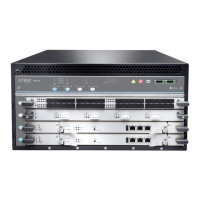•
Two interfaces from the SCBs that enable the DPCs to be powered on and controlled.
•
Physical DPC connectors.
•
Two or four Packet Forwarding Engines.
•
Midplane connectors and power circuitry.
•
Processor subsystem, which includes a 1.2-GHz CPU, system controller, and 1 GB of
SDRAM.
•
Online button—Takes the DPC online or offline when pressed.
•
LEDs on the DPC faceplate. For more information about LEDs on the DPC faceplate,
see the MX Series Interface Module Reference.
Two LEDs, located on the craft interface above the DPC, display the status of the DPC
and are labeled OK and FAIL.
Related
Documentation
DPC and MPC LEDs on the MX240 Craft Interface on page 15•
• MX240 Field-Replaceable Units (FRUs) on page 225
• Replacing an MX240 DPC on page 297
MX240 DPC Port and Interface Numbering
Each port on a DPC corresponds to a unique interface name in the CLI.
In the syntax of an interface name, a hyphen (-) separates the media type from the DPC
number (represented as an FPC in the CLI). The DPC slot number corresponds to the first
number in the interface. The second number in the interface corresponds to the logical
PIC number. The last number in the interface matches the port number on the DPC.
Slashes (/) separate the DPC number from the logical PIC number and port number.
type-fpc/pic/port
•
type—Media type, which identifies the network device. For example:
•
ge—Gigabit Ethernet interface
•
so—SONET/SDH interface
•
xe—10-Gigabit Ethernet interface
For a complete list of media types, see Interface Naming Overview.
•
fpc—Slot in which the DPC is installed. On the MX240 router, the DPCs are represented
in the CLI as FPC 0 through FPC 2.
•
pic—Logical PIC on the DPC. The number of logical PICs varies depending on the type
of DPC. For example, a:
•
20-port Gigabit Ethernet DPC has two logical PICs, numbered 0 through 1.
•
40-port Gigabit Ethernet DPC has four logical PICs, numbered 0 through 3.
51Copyright © 2017, Juniper Networks, Inc.
Chapter 6: Line Card Components and Descriptions

